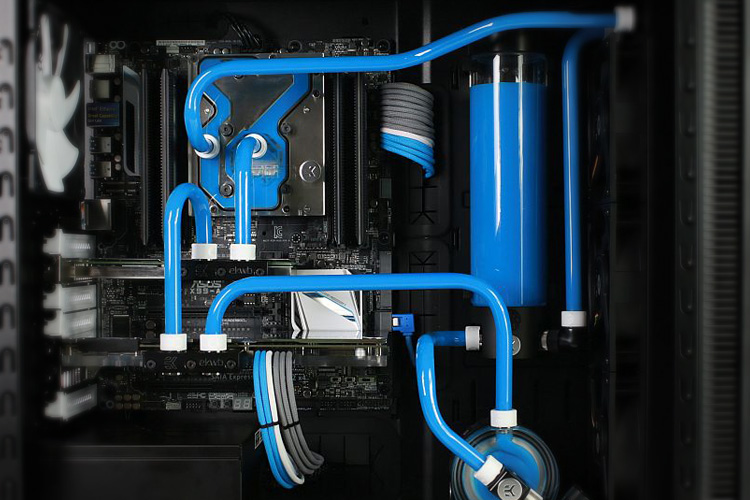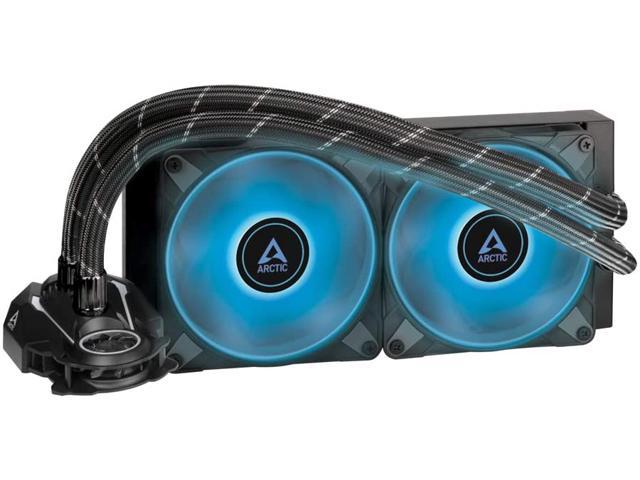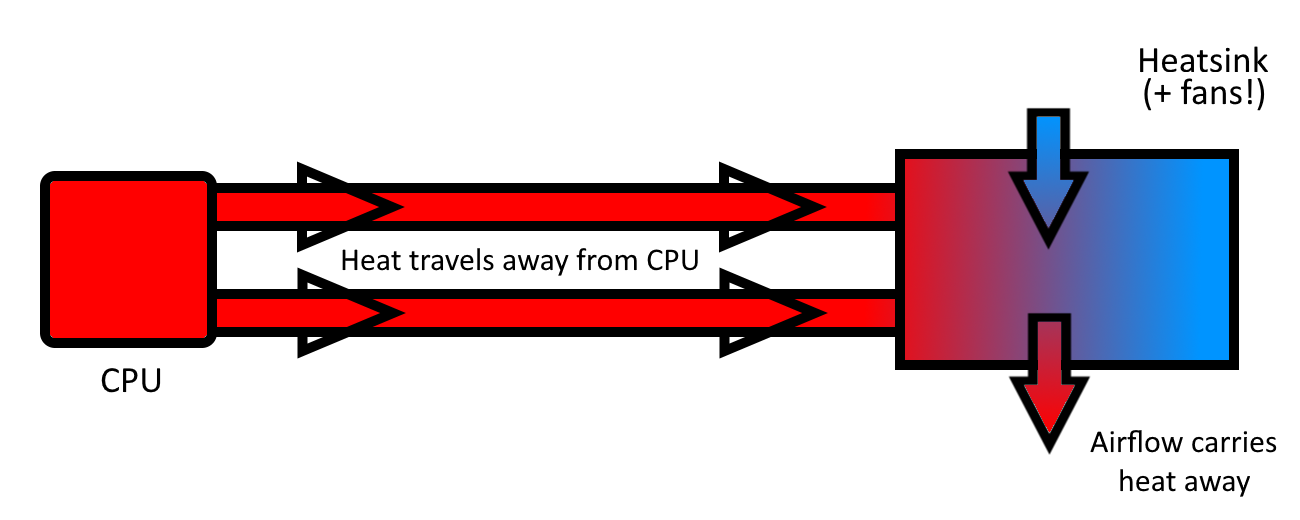
Air cooling versus liquid cooling is a debate as old as time. Indeed, even the dinosaurs tens of millions of years ago often argued deep in the forests of Pangaea whether air or liquid is the superior form of CPU cooling. With their methods of record-keeping lost to time, sadly we may never know the conclusions they reached…
But we can give you a pretty good idea of which cooling method suits your needs the best here in 2022.
The Basics of CPU Cooling
Let’s begin by first examining the basic elements of coolers that are constant across all methods of chilling that tiny spicy chip at the heart of your build. All coolers have the following pair of ideas in common:
Heat is removed from the CPU via conduction, which is the direct transfer of heat between two materials in contact with each other. Both air and liquid coolers use this mechanism, which is typically a copper plate that whisks heat away to metal fins or another conducting plate, either of which can be the site of the following heat exchange:
The heat drawn away from the CPU is then exchanged at an interface via convection, which is the transfer of heat through the continuous flow of a gas or fluid. In air and liquid coolers the media are, as you probably guessed, air and liquid respectively. The heat from this warm medium is then dumped into the air outside of the system via the PC’s exhaust fans.
So, as you can see, the fundamental method is the same in either type of cooler; it’s only exactly how the heat gets from the CPU to a fluid inside the case to the air outside the case that differs.
Air Cooling

A simple, popular example of an air cooler
Air coolers use a ‘block’ of thin metal fins called a heat sink to exchange heat with the cool air arriving from your intake fans. Heat radiates from the CPU through the copper plate and out into the fins, which have a large surface area to exchange lots of heat. Like two slices of bread in a delicious sandwich, a pair of fans typically sit on both vertical sides of the heat sink, ideally in line with your case fans. Some higher-end air coolers may include multiple heat sinks in series to increase their cooling potential, while simpler and cheaper ones may only include one heat sink and one fan.
Stock air coolers, like the one that came with your processor and never left the box, have a handful of uses: they’re more than enough for basic office computers, and most of them are low-profile options which can be great for ‘small form factor’ builds. But for those pushing their systems in any way, stock coolers are usually only useful to hold a system over until r/buildapcsales presents a better cooling solution. They’ll work, but most will eventually want a quieter or cooler option. Luckily, you can find an excellent air cooler for as little as $40, and I’ll go into a few recommendations below. Air cooling can be a quiet, powerful, and efficient way to cool your CPU.
Liquid Cooling

An example of an all-in-one liquid cooler
Liquid cooling operates with two distinct advantages over air cooling: liquids can absorb more heat than air, and the radiator can be positioned away from the CPU’s cooling plate. While that first advantage is the more obvious one, it’s only in combination with the second advantage that liquid cooling becomes a truly powerful choice. After all, if the liquid was just sitting in a radiator on top of the CPU and getting blasted with fans there, the whole thing would be incredibly similar to an air cooler in terms of overall function.
Because the fans are installed on a radiator that sits flush with the inside of a case wall, however, the heat is contained and dispensed directly from the cooler itself to the exterior of the case, helping to prevent heated air from staying inside of the system. Moreover, with the radiator positioned away from the CPU, space is freed up and a cleaner appearance is created around the center of your motherboard.
Liquid coolers achieve this by placing a pump on top of the CPU that constantly keeps liquid flowing. After collecting heat from the processor, the liquid gets sent through a tube to the radiator where it’s cooled off, then flows back to the pump in separate tube to collect heat again. The liquid used is often ordinary water, but some loops can feature ionized water, glycol solutions, or other electrically inert liquids.
Consumer liquid cooling exists in two major forms: all-in-one (AIO) solutions and custom loops. Both operate on the same principle: using fluid to sweep heat away from your CPU to the radiator, where the liquid flows through narrow channels with high surface area to exchange heat to the air, which is in turn cycled by fans.
AIO coolers are prebuilt water cooling circuits that include everything you need right out of the box, with a design adaptable enough to fit in most modern computers. Custom loops, on the other hand, are not “solutions” so much as “voluntary challenges”. You’re tasked with designing and building an entire water-cooling circuit that is hand-crafted for your PC. And it actually needs to function afterwards! (Without leaking, of course.) The primary benefit—beyond bragging rights, of course—is that you can include your GPU in the circuit as well, providing powerful liquid cooling to the hottest component in your PC. Very cool!
For 99% of PC builders that opt for a liquid cooler, you’re going to want AIO cooling. As such, those will be the only liquid coolers I recommend below. It’s much cheaper, safer, and easier than attempting to build a custom loop without lengthy experience or a decade of mentorship under a plumber. A custom loop is more like a work of art than a strict mechanical necessity; it’s the height of hand-crafted computer building. Custom loops bring unmatched performance, but carry a tremendous price tag and require exceptional patience and care to create.
Most liquid coolers, custom loop or not, will cool more effectively than an air cooler, but it will cost more money-per-degree-reduced. This is true for AIOs, and is a massive understatement for custom loops, to say the least.

Custom liquid cooling looks (And is!) very interesting, but is extraordinarily difficult for a novice builder. (Photo source: ekwb)
Liquid cooling can also be set up in multiple ways, giving you some choice in where you mount the radiator. It’s generally recommended that you place your radiator either in front of or behind your case’s intake fans. This means the liquid in your radiator receives the cold intake air as opposed to exhaust air that’s already been warmed by other components if you were to mount the radiator to exhaust fans.
There’s some debate as to whether mounting the radiator specifically in front of or behind the case fans is better, but you’ll find equal performance in either situation. The tradeoff, of course, is that air heated by the CPU Cooler’s radiator will now be inside the case and liable to heat other components before being exhausted; CPUs, however, are more likely than other parts to see a noticeable reduction in performance due to heat, so it’s still my recommended configuration.
“Which is right for me? Air cooling or liquid cooling?”
This hinges on a few factors, depending on which of the following is most important to you.
Budget:
Without a doubt, air cooling is the way to go if you’re budget-conscious. A $50 air cooler from Noctua or be quiet! will compete extremely closely to the cheapest possible liquid coolers, which can easily cost $70+. The cheapest reputable liquid coolers feature radiators that are only 120mm wide, meaning they can only support a single fan. These compact liquid coolers sacrifice a massive amount of cooling potential to become as cheap as possible, making their increased cost relative to a good air cooler harder to justify.
Performance:
For a greatly increased price, liquid cooling can potentially keep your CPU cooler due to improved thermodynamics compared to air coolers. Powerful liquid coolers truly shine when paired with beefy overclocked CPUs, which together can crank out unbelievable performance at excellent temperatures. In addition, liquid cooling’s increased efficiency means that fans don’t have to run as fast to keep your computer equally cool, so they also result at decreased noise levels.
Appearance:
This one is entirely subjective, but it’s still worth noting since most computer cases now feature large transparent side panels for you to admire your machine’s innards. Many modern air coolers incorporate a design that fits in better with current computer parts, but some still sport large, cheap-looking aluminum blocks that can look dated among blacked-out, cutting edge components. As noted before, liquid coolers lend themselves to better looks—whether by simply getting out of the way with an AIO, or by becoming the main attraction with a custom loop.
“Okay, I think I know which method I prefer… Now which cooler should I buy?”
The following suggestions are broad recommendations that will likely satisfy most consumers at various prices. But don’t forget to explore similar models that may suit your needs better!
And, as always, check compatibility of these parts with your specific components (especially your CPU, motherboard, and case) before purchasing! Some coolers, like the ARCTIC Liquid Freezer II, feature very large pump units that can interfere with adjacent components depending on the layout of your motherboard. As always, check before you buy! Caveat emptor isn’t just a saying; it’s a way of life.
Recommended Air Coolers
Hyper 212 EVO V2 ($48)

The second iteration of what has long been considered one of the greatest budget air coolers of all time. An excellent, simple unit from Cooler Master at an unbeatably great price. Single fan means a little less performance, but reduced sound levels compared to other options. There’s a variety of designs, including all-black and RGB options at various prices. Any variant will do the job!
be quiet! Shadow Rock 3 ($54)

be quiet!, as the name would suggest, make exceptionally quiet air cooling units. The Shadow Rock 3 is a great, budget-oriented cooler that doesn’t sacrifice performance. High fin density and a single-fan design keeps your CPU cool and quiet while you game or browse in peace.
be quiet! Dark Rock Pro 4 ($90)

This twin-fan, twin-heat-sink unit from be quiet! checks just about every box for an air cooler. Quiet, high-performance, near-budget pricing (for a large unit), and an understated appearance make this inconspicuous model a powerhouse of cooling potential. Hard not to recommend!
Noctua NH-U12A ($110)

An extremely powerful twin-fan air cooler from Noctua, that will compete with a variety of liquid cooling options. If you aren’t familiar with Noctua, they make superbly powerful and reliable fans, which means this cooler will pack a punch and last a lifetime. If beige and polished aluminum are too 70s for you, you can spend $10 more for the all-black “Chromax” edition for a more contemporary look.
Recommended Liquid Coolers
Cooler Master ML240L RGB V2 ($80)

The cheapest recommended 240mm liquid cooling unit. Cooler Master makes good products at excellent prices, and this ML240L liquid cooler has gone through several iterations over the years to have many of the QA quirks ironed out. Many high-end air coolers will still cool better than the ML240L, but for the price you get quite an impressive unit that features customizable RGB lighting and the perks inherent to liquid cooling solutions. Not a bad choice!
ARCTIC Liquid Freezer II 240 RGB ($112)

A stunningly powerful 240mm liquid cooler from a manufacturer that tends to fly under the radar. ARCTIC produce liquid coolers with performance that blows away the competition. This updated model features RGB lighting in the fans, and a unique pump design that looks like something the predator would use to fight a terminator. But it’s worth highlighting that the pump unit, as well as the thicker radiator which gives this cooler it’s characteristic performance, may create compatibility issues if you have a compact case or motherboard. Always double-check compatibility before buying!
Corsair h100i Elite Capellix ($150)

Corsair’s liquid coolers are some of the best and most popular options on the market, and the h100i has long been the standard in recommended 240mm liquid coolers. Incredibly powerful cooling with nearly all the bells and whistles you could ask for, at a reasonable price. Twin high-RPM magnetic levitation fans provide great airflow through the radiator, and the highly customizable lighting effects through iCue let you make this cooler entirely your own.
be quiet! Pure Loop 360mm ($130)

Excellent liquid cooler from be quiet! that provides incredible cooling due to it’s extra long 360mm radiator. This design utilizes three fans to do more liquid cooling than other liquid coolers when it cools liquid… but accordingly it requires three adjacent fan slots to be installed. Technically, it has been succeeded by the Pure Loop 2, but that unit is $100 more. Save the Benjamins and opt for the original model, if it’s still available!
Conclusion
We’ve gone over a lot of information! We explored how various CPU coolers work, the differences between liquid and air cooling, and the advantages and disadvantages of each. Regardless of your decision, any of the recommended cooling options in the previous section should keep you and your processor happy in almost any activity, from slaying enemies to working on excel files.
Didn’t see a cooler you like on our list? Have a question? Just want to tell me my hair looks nice today? Leave us a comment and tell us what you think! (Positive feedback only for the hair, please). Thanks for reading!







